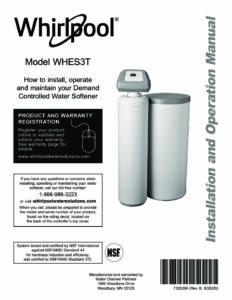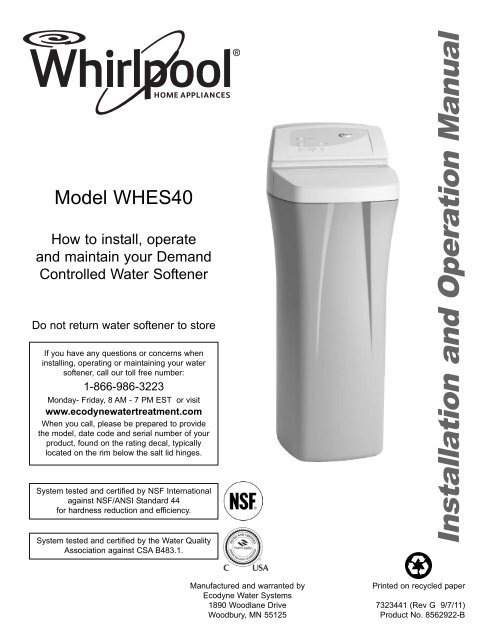To troubleshoot a Whirlpool water softener, check for salt bridging and low salt levels. Clean the nozzle and venturi.
Dealing with a malfunctioning water softener can be frustrating. If you’re experiencing issues with your Whirlpool water softener, it’s essential to address them promptly to ensure your water remains soft and free of minerals. By following a few simple troubleshooting steps, you can identify and resolve common problems with your water softener.
We will explore some of the most common issues that may arise with Whirlpool water softeners and provide practical solutions to help you get your system back up and running smoothly.
Introduction To Whirlpool Water Softeners
Whirlpool water softeners are renowned for their efficiency in removing hard minerals from water, providing you with softer, cleaner water for everyday use.
Why Choose Whirlpool?
Whirlpool water softeners are known for their durability, effectiveness, and user-friendly features.
Common Issues With Water Softeners
Some common issues with water softeners include salt bridging, low water pressure, and system leaks.
Identifying Your Model
To troubleshoot your Whirlpool Water Softener, start by identifying your specific model for accurate solutions. Consult the manual or check the product label for the model number. This step is crucial to effectively addressing any issues with your water softener system.
Where To Find Model Information
To troubleshoot your Whirlpool water softener, you must first identify the model you own. This information is critical to determining the necessary steps to resolve the issue. The model number can be found in several locations. The most common is on the label attached to the unit itself. This label can typically be found on the side of the tank or the control valve. If this label is missing, you can also find the model number in the owner’s manual that came with the water softener.
Importance Of Knowing Your Model
Knowing your model number is crucial when it comes to troubleshooting your water softener. Each model has unique features, parts, and settings that require specific solutions to fix any problems. Attempting to troubleshoot without knowing the model number could result in further damage to the unit or even personal injury. Once you have identified your model, you can refer to the owner’s manual or contact Whirlpool customer support for guidance on how to resolve any issues.
In conclusion, identifying your model number is the first step in troubleshooting your Whirlpool water softener. Ensure that you locate the model number before attempting any repairs to avoid further damage to the unit.
Basic Troubleshooting Steps
When it comes to maintaining your Whirlpool water softener, understanding basic troubleshooting steps can help you address common issues quickly and efficiently. By following these simple steps, you can resolve minor problems without the need for professional assistance.
Initial Checks And Settings
Before delving into more complex troubleshooting, start by performing some initial checks and verifying the settings of your Whirlpool water softener. Ensure that the power source is connected and that the unit is receiving electricity. Check the water supply to confirm that it’s flowing adequately into the softener. Review the settings to ensure they are configured correctly according to the user manual.
Resetting The System
If you encounter persistent issues with your Whirlpool water softener, performing a system reset may help resolve the problem. Begin by turning off the power to the unit and disconnecting it from the electrical outlet. After a few minutes, reconnect the power and turn the unit back on. This simple reset can often clear minor glitches and restore the softener to proper functioning.

Credit: whirlpoolwatersolutions.com
Common Error Codes And Their Meanings
When your Whirlpool water softener displays error codes, it can be frustrating and confusing. Understanding the common error codes and their meanings can help you troubleshoot the issues effectively. In this article, we will delve into the interpretation of error codes and provide steps to resolve specific codes.
Error Code Interpretation
Whirlpool water softeners may display error codes to indicate specific issues. Understanding these codes is crucial for accurate troubleshooting. Here are some common error codes and their meanings:
| Error Code | Meaning |
|---|---|
| Err1 | Low water pressure |
| Err2 | Salt bridging or salt tank empty |
| Err3 | Valve motor failure |
| Err4 | High water usage |
Steps To Resolve Specific Codes
When encountering specific error codes, follow these steps to resolve the issues:
- Err1 – Low water pressure: Check for clogged filters or plumbing issues. Ensure adequate water flow to the softener.
- Err2 – Salt bridging or salt tank empty: Break up the salt bridge or refill the salt tank as needed. Ensure proper salt levels for optimal performance.
- Err3 – Valve motor failure: Inspect the valve motor and wiring for any damage. Replace the motor if necessary.
- Err4 – High water usage: Monitor water consumption and adjust settings if required. Investigate potential leaks or excessive water usage.
By understanding the error codes and following the appropriate troubleshooting steps, you can effectively address issues with your Whirlpool water softener and ensure uninterrupted operation.
No Salt In the brine tank
Experiencing the issue of no salt in the brine tank of your Whirlpool water softener can lead to hard water and decreased efficiency. This can occur due to various reasons, but with proper troubleshooting and maintenance, you can easily resolve this problem.
Causes Of Low Salt Levels
Low salt levels in the brine tank can be attributed to several factors. Firstly, it may be due to infrequent refilling of the salt. Secondly, salt bridges or mushing can form in the tank, preventing proper salt dissolution. Lastly, incorrect settings or malfunctioning components can also lead to low salt levels.
How To Refill Properly
When refilling the brine tank, ensure to use high-quality salt pellets to prevent bridging and mushing. Also, be cautious not to overfill the tank, as it can lead to salt overflow. Additionally, regularly check and maintain the salt level to ensure optimal performance of the water softener system.

Credit: www.yumpu.com
Issues With Water Flow
When troubleshooting your Whirlpool water softener, it’s important to address issues with water flow. Common problems can include blockages and the need to adjust the flow control. By understanding these issues and how to resolve them, you can ensure that your water softener operates effectively.
Checking For Blockages
If you’re experiencing reduced water flow, check for blockages in the system. Start by inspecting the inlet and outlet valves for debris or buildup. You can also remove and clean the water softener’s resin bed to ensure proper water flow. Regular maintenance in this aspect can prevent blockages and maintain optimal performance.
Adjusting The Flow Control
Another potential cause of water flow issues is an improperly adjusted flow control. Check the flow control settings to ensure they are appropriate for your household’s water usage. Adjusting the flow control according to the manufacturer’s guidelines can help regulate the water flow and ensure consistent softening efficiency.
Water Feels Hard After Treatment
Following whirlpool water softener troubleshooting, the water may feel hard after treatment, indicating potential issues. It’s essential to check settings and maintenance for optimal performance. Regularly monitor and adjust the softener to ensure consistently soft water in your home.
Water Feels Hard After Treatment is a common issue that many Whirlpool water softener users face. This problem arises when the softener fails to remove all the hard minerals from the water, leaving it feeling hard. However, there are some easy troubleshooting steps that you can take to resolve this issue.
Testing Water Hardness
The first step in troubleshooting this issue is to test the hardness of your water. You can do this by using a water hardness test kit, which is readily available in the market. Simply follow the instructions on the kit to test the hardness of your water. If the test shows that your water is still hard, then it means that your softener is not functioning properly.
Calibrating The Softener
Calibrating the softener is another step that you can take to resolve this issue. Start by turning off the power to the softener, then locate the calibration knob. Turn the knob until it reads the correct hardness level for your area. Once you have calibrated the softener, turn the power back on and let it run for a few cycles to ensure that it is working correctly.
If the above steps do not resolve the issue, then it is recommended that you seek the help of a professional. A qualified technician will be able to diagnose the problem and recommend the best course of action.
In conclusion, if you are facing the issue of Water feeling Hard After Treatment with your Whirlpool water softener, then it is essential to take the necessary steps to troubleshoot the problem. By testing the water hardness and calibrating the softener, you can ensure that your softener is working correctly and delivering soft water.
Professional Maintenance Tips
Discover effective maintenance tips for troubleshooting your Whirlpool Water Softener. Learn how to optimize performance and address common issues efficiently. Keep your system running smoothly with these professional insights and ensure your water stays soft and pure.
When To Call A Professional
For complex issues like electronic malfunctions or internal component problems.
Preventive Maintenance Practices
Regularly clean the resin tank and refill it with quality salt pellets.
Check and adjust regeneration cycles as needed to optimize performance.
- Inspect for salt bridges or mushing, breaking up any accumulations.
- Ensure the brine tank is clean and free from contaminants.
Periodic professional servicing can prevent major issues and extend the lifespan of your water softener.
DIY Repair Guides
When it comes to troubleshooting your Whirlpool water softener, DIY repair guides can be a lifesaver. These guides empower you to tackle common issues and perform necessary repairs without the hassle of hiring a professional. Below, you’ll find helpful information on replacing common parts and the essential tools needed for home repairs.
Replacing Common Parts
If you encounter problems with your Whirlpool water softener, replacing common parts can often resolve the issue. Common parts that may need replacement include the resin bed, brine valve, or control board. Follow the manufacturer’s instructions carefully when replacing these parts.
Tools Needed For Home Repairs
Having the right tools at your disposal is crucial for successful home repairs. Essential tools for repairing your Whirlpool water softener include adjustable wrenches, screwdrivers, pipe cutters, and tubing cutters. These tools enable you to disassemble the unit, replace parts, and reassemble it with ease.

Credit: www.youtube.com
Frequently Asked Questions
How Can You Tell If Your Water Softener Is Clogged?
To check for a clogged water softener, observe reduced water flow, dry skin, and cloudy dishes. Regular maintenance prevents clogs.
Should There Be Water In The Bottom Of My Whirlpool Water Softener?
Yes, there should be water in the bottom of your Whirlpool water softener to properly function.
How Do I Know If My Whirlpool Water Softener Is Working?
To check if your Whirlpool water softener is working, monitor salt levels, look for scale buildup, and test water hardness.
Why Is My Whirlpool Water Softener Full of Water?
A full Whirlpool water softener is usually caused by a malfunctioning valve or a clogged drain line. The valve may not be closing properly, or there could be a blockage in the drain line, causing water to constantly fill the tank.
A professional technician can diagnose and fix the issue.
How Do I Reset My Whirlpool Water Softener?
To reset your Whirlpool water softener, press and hold the ‘Recharge’ button for 3 seconds.
Conclusion
In troubleshooting your Whirlpool water softener, remember to check settings and connections. Regular maintenance can prevent issues. Consult the manual or contact customer support for assistance. Stay proactive to ensure your system runs smoothly and provides quality, softened water for your household needs.
